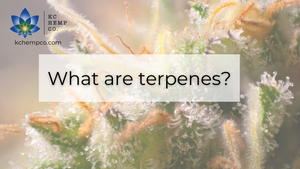What are Terpenes?
And why are they crucial to your cannabis experience?
Watch our co-owner Heather and read the blog below to find out!
Have you ever smelt the fresh scent of a lemon or an orange? Have you ever been put to sleep with a relaxing lavender bath? What about the exhilarating aroma of crisp pines in the mountains? Welcome to the world of terpenes! Most certainly something you’re already familiar with, but maybe didn’t know they had a specific name! Terpenes are aromatic compounds found within plants (and some insects) that contribute to their flavor and smell. Molecularly speaking, they are unsaturated hydrocarbons with an isoprene unit and at least 8 Carbons!
Terpenes play a vital role for the plants and animals they come from. Some terpenes act as a repellent, keeping the plant safe from foragers, while others act a signal scent for pollinators!
Isolated terpenes are used in everyday items such as perfumes, lotions, and even some foods. They work by enhancing the flavor and the scent of some of your favorite products.
Think for a moment about apples and oranges. think about their distinct smells and aromas as you bite into them. You might describe them as sweet, or citrusy, maybe even sour, or sugary. What you are describing is the terpene profile of that fruit. Cannabis is no different, depending on the strain.
Cannabis strains are most distinguishable for the terpenes found within the flowers (or buds). In fact, the effect of a cannabis strain can be broken down in three units:
Sativa (uplifting)
Indica (relaxing/sedative)
Hybrid (a mix between the two).
Each of these classifications is due in part to the terpene profiles of the plant!
Types of Terpenes:

There are hundreds of terpenes found within nature. Each of them have a unique and different role they take. Here are a few of the most common within the cannabis plant:
Myrcene (meer seen)-
Aroma: musky, herbal, and somewhat citrusy
Potential Effect: anti-inflammatory, sedative, muscle relaxant, pain relief
Limonene (lim o kneen)
Aroma: citrusy, lemony, orangey
Potential Effect: improves mood, anti-anxiety, anti-depressant, nausea relief
Linalool (lin a lool)
Aroma: floral, sugary, citrusy
Potential Effect: anti-anxiety, sedative, pain relief, anti-bacterial
Caryophyllene
Aroma: Spicy, woody, peppery
Potential Effects: pain relief, anti-depressant, anti-inflammatory, anti-anxiety
Ɑ-pinene and 𝛃-pinene (pine kneen)
Aroma: piney, fresh mountain air, slightly woody
Potential Effects: mood boosting, improves focus, bronchodilator, improve memory
Join us on our YouTube Channel: CBD’s Modern Family, every Tuesday for “Terpene Tuesday” where we deconstruct each terpene in full detail and discuss its aroma, where they are commonly found, potential effect on the body and prominent cannabis strains!
How Do Terpenes Affect People?
Terpenes are bioactive compounds and therefore DO have an affect on people! Dependent on how they are used and the concentration in which they are used can determine what effect they have.
Terpenes are the basis for essential oils which are used in a lot of holistic healing practices. For example, aromatherapy is the practice of smelling essential oils in an effort to alleviate an unfavorable feeling like stress and anxiety.
Can terpenes affect my pets?
Some house pets such as dogs, cats and birds are sensitive to the uses of essential oils and terpenes. Birds, in particular, are sensitive to any use of diffusers or similar methods for aromatic use of essential oils. This is due to their delicate respiratory system. If you have pets, always check and make sure the oils you're using are safe for your animal.
What is Terpene Toxicity?
Terpenes have a profound effect on our bodies and with that we have to be careful to not over use them. As with everything, too much of anything, can be a bad thing!
Terpenes are no exception to this rule. In fact, overuse can result in problems such as irritated lungs and skin issues. Certain terpenes are considered photosensitive, which means they are greatly impacted by the sun. It is recommend to not use products with these terpenes when you plan on having direct sun exposure!
Always check the ingredients of your lotions and hair care products, to specifically look for citrus based terpenes as these tend to be photosensitive, leading to severe sun burns and possibly pre-cancerous conditions on the skin.
How are terpenes different from cannabinoids:
Cannabinoids are chemical compounds unique to the cannabis plant. The two most familiar compounds are THC and CBD.
THC, tetrahydrocannabinol, is the cannabinoid responsible for the “high” or euphoric feeling associated with cannabis use. It works by targeting specific receptors within your Endocannabinoid System.
CBD, or cannabidiol, also works within your Endocannabinoid System but doesn’t cause the psychotropic effects like that of THC. As more research is done, CBD has been shown to have the potential to help with a variety of issues such as: anxiety, depression, pain and inflammation!
Terpenes, a chemically different aromatic compound, are found in abundance within the cannabis plant as well but also reside in a variety of other plants and even some animals. Much like cannabinoids, terpenes have the ability to work within the Endocannabinoid System as well.
It is assumed that terpenes can affect the “high” or increase the effectiveness of cannabinoids within the ECS. When terpenes and cannabinoids work together they create what is known as the “Entourage Effect”.
A Brief Overview of the Entourage Effect
Terpenes play a vital role in the effectiveness of cannabis and hemp based products. They are responsible for creating what is known as “The Entourage Effect”. The great philosopher Aristotle once said “The whole is greater than the sum of the parts” that in a nutshell is the entourage effect.
You have all of these wonderful pieces of the plant: cannabinoids, terpenes, raw plant matter, etc. When we look at their abilities singularly, they offer established benefit. But, to really receive the full host of benefits each one has to offer, you need them to all work harmoniously together.
Cannabinoids need the help of terpenes and vice versa to provide the best health benefits to the consumer. We often hear of the entourage effect being some combination of CBD, THC, and other cannabinoids.
Scientists have some exciting work cut out for them as they continue to research and study the health benefits associated with the combinations of 100 plus cannabinoids and terpenes.

